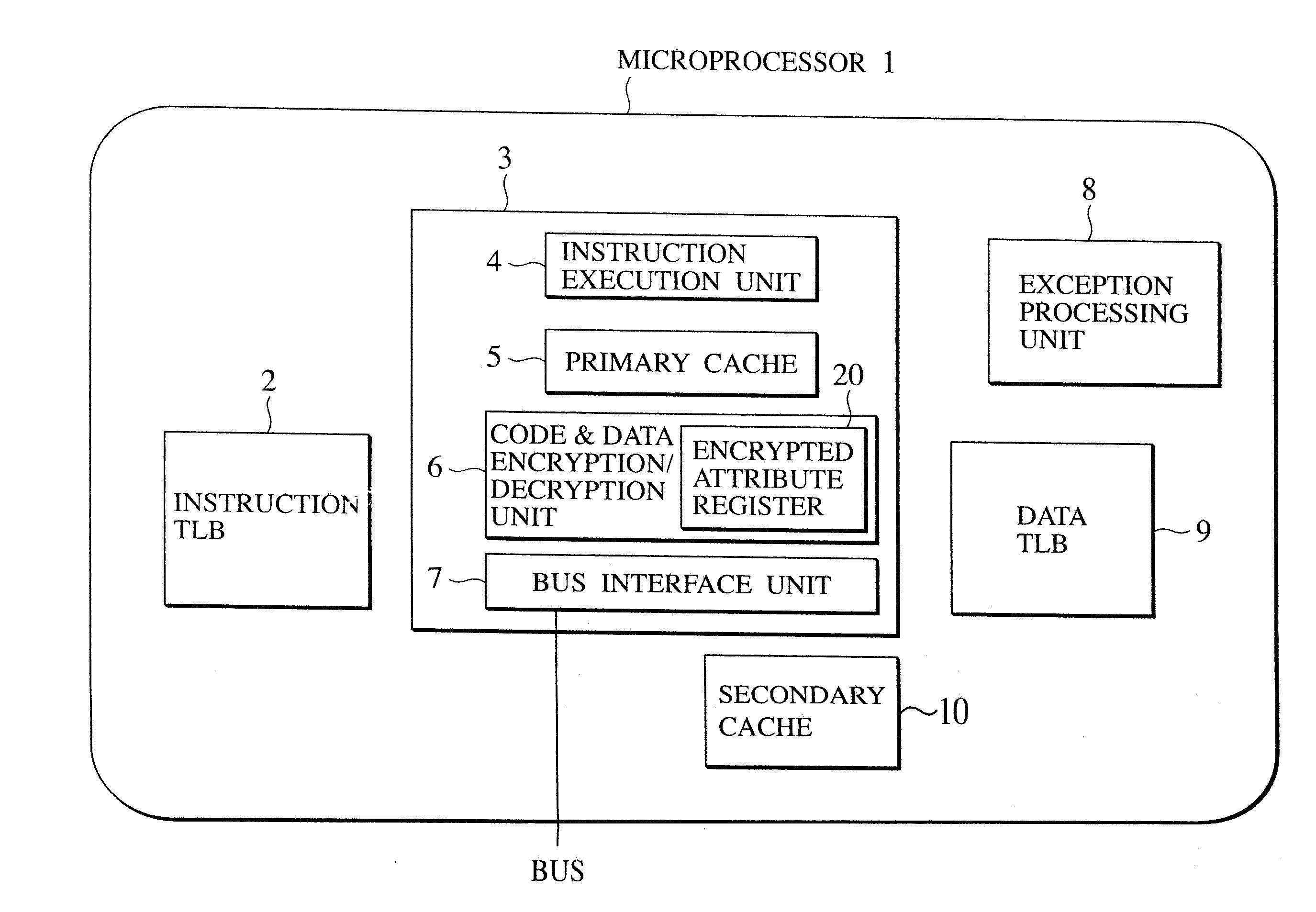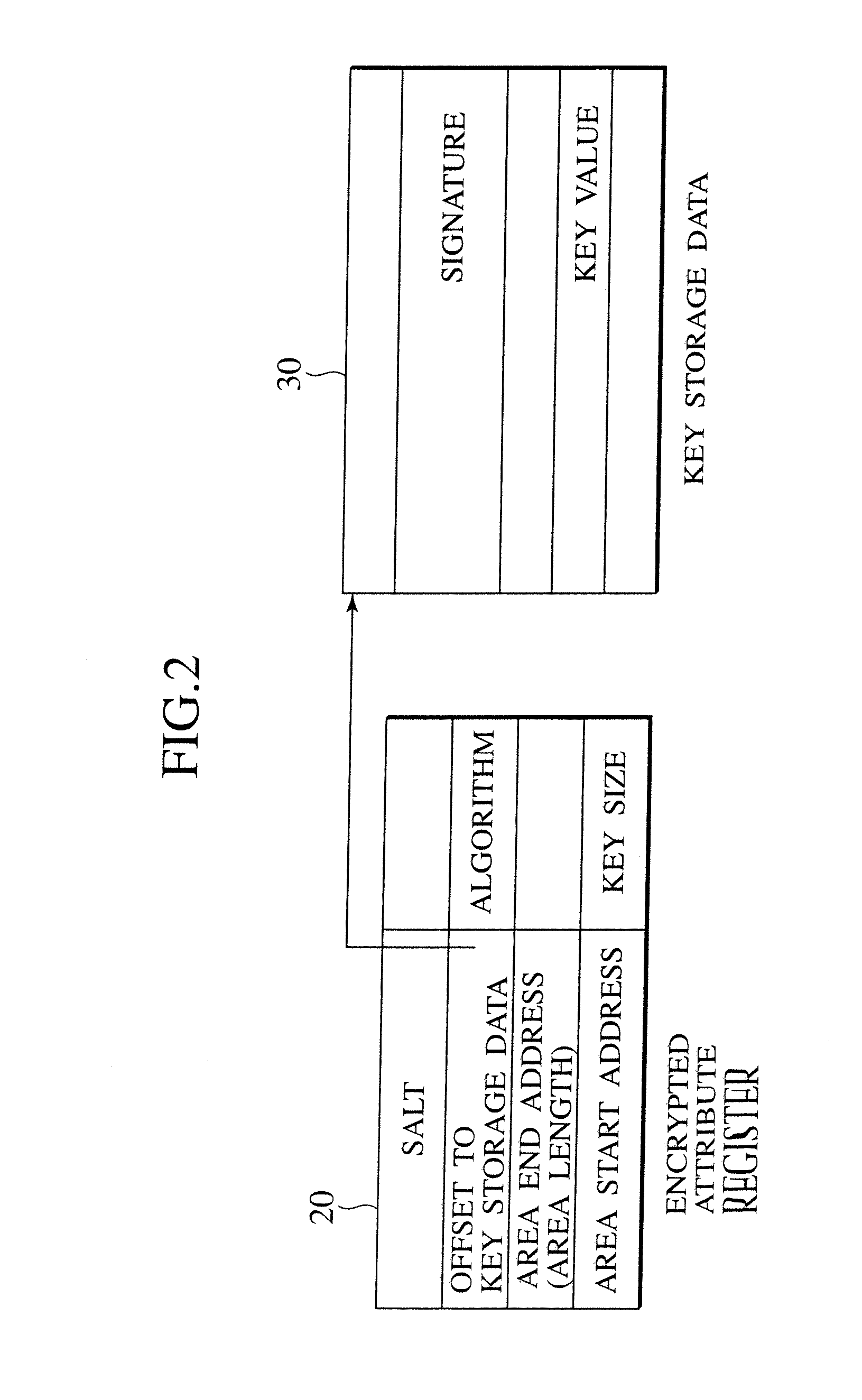Method for sharing encrypted data region among processes in tamper resistant processor
a technology of encryption and data region, applied in the field of microprocessors, can solve the problems of not allowing the protection of program operation and data secrecy, affecting the protection of original image or music copyright, and difficult analysis using tools such as de-assembler or debugger
- Summary
- Abstract
- Description
- Claims
- Application Information
AI Technical Summary
Benefits of technology
Problems solved by technology
Method used
Image
Examples
first embodiment
[0114] In the first embodiment, the method for sharing the encrypted data region that is available only between two processes will be described.
[0115] Here, data to be read / write with respect to the shared data region to be generated here is encrypted / decrypted by a hardware inside the microprocessor and hidden from the other processes which do not know the key.
[0116] In order to share some encrypted data region between different processes, there is a need for a function for sharing the encryption / decryption key to be used with respect to that data region between the two processes, in addition to the function for sharing the memory supported by the ordinary OS. There are two methods for realizing this.
[0117] The first method is the simplest method in which the programs for the inter-process sharing are put in a state of knowing the key for the encrypted data region to be shared in advance or a state capable of sharing the key for the encrypted data region to be shared.
[0118] The...
second embodiment
[0141] In the first embodiment, the shared encrypted data region is realized by carrying out the key exchange between two processes and registering the common key in the respective encrypted attribute registers. The second embodiment provides the method for sharing the encrypted data region more safely by carrying out the authentication in the key exchange.
[0142] In the method of the first embodiment, when there is a malicious program such as altered OS intervening between two processes that carry out the key exchange, there is a possibility for an attack called “man in the middle attack”. Namely, there is a possibility for the intervening program to forge the information necessary for the key generation and freely eavesdrop or alter the encrypted data by manipulating the keys arbitrarily.
[0143] If it is a system for which there is no way of having a malicious altered program inserted into the system, the application of the key exchange scheme of the first embodiment will cause no...
third embodiment
[0162] The first and second embodiments are directed to the method for sharing the shared encrypted data region between two processes. In the third embodiment, a procedure for constructing a shared encrypted data region Hshare to be shared among three or more processes will be described.
[0163]FIG. 7 shows respective address spaces of the processes A, B and C, and an exemplary configuration of the shared encrypted data region to be shared by these processes. In the example of FIG. 7, the process A is an owner process which is a creator of the shared encrypted data region Hshare. FIG. 8 shows an exemplary configuration of the encrypted attribute registers of the respective processes for the purpose of creating the shared encrypted data region.
[0164] First, the owner process A is shifted to the encrypted instruction execution mode, and creates the shared encrypted data region Hshare 106 in its own address space. A key Kshare for the region Hshare may be embedded in the program code i...
PUM
 Login to View More
Login to View More Abstract
Description
Claims
Application Information
 Login to View More
Login to View More - R&D
- Intellectual Property
- Life Sciences
- Materials
- Tech Scout
- Unparalleled Data Quality
- Higher Quality Content
- 60% Fewer Hallucinations
Browse by: Latest US Patents, China's latest patents, Technical Efficacy Thesaurus, Application Domain, Technology Topic, Popular Technical Reports.
© 2025 PatSnap. All rights reserved.Legal|Privacy policy|Modern Slavery Act Transparency Statement|Sitemap|About US| Contact US: help@patsnap.com



